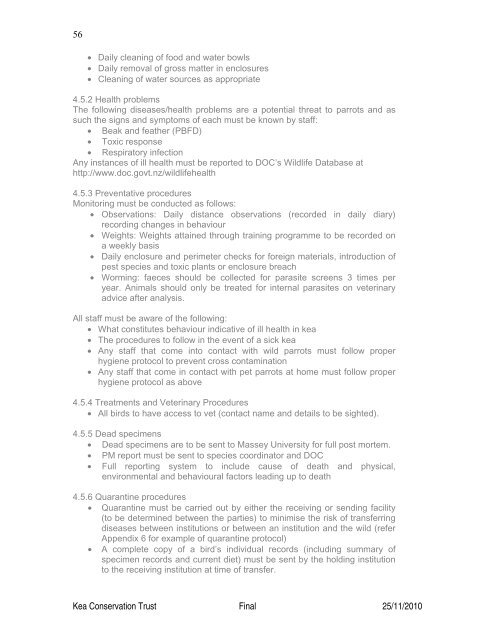(Nestor notabilis) Husbandry Manual - Kea Conservation Trust
(Nestor notabilis) Husbandry Manual - Kea Conservation Trust
(Nestor notabilis) Husbandry Manual - Kea Conservation Trust
Create successful ePaper yourself
Turn your PDF publications into a flip-book with our unique Google optimized e-Paper software.
56<br />
• Daily cleaning of food and water bowls<br />
• Daily removal of gross matter in enclosures<br />
• Cleaning of water sources as appropriate<br />
4.5.2 Health problems<br />
The following diseases/health problems are a potential threat to parrots and as<br />
such the signs and symptoms of each must be known by staff:<br />
• Beak and feather (PBFD)<br />
• Toxic response<br />
• Respiratory infection<br />
Any instances of ill health must be reported to DOC’s Wildlife Database at<br />
http://www.doc.govt.nz/wildlifehealth<br />
4.5.3 Preventative procedures<br />
Monitoring must be conducted as follows:<br />
• Observations: Daily distance observations (recorded in daily diary)<br />
recording changes in behaviour<br />
• Weights: Weights attained through training programme to be recorded on<br />
a weekly basis<br />
• Daily enclosure and perimeter checks for foreign materials, introduction of<br />
pest species and toxic plants or enclosure breach<br />
• Worming: faeces should be collected for parasite screens 3 times per<br />
year. Animals should only be treated for internal parasites on veterinary<br />
advice after analysis.<br />
All staff must be aware of the following:<br />
• What constitutes behaviour indicative of ill health in kea<br />
• The procedures to follow in the event of a sick kea<br />
• Any staff that come into contact with wild parrots must follow proper<br />
hygiene protocol to prevent cross contamination<br />
• Any staff that come in contact with pet parrots at home must follow proper<br />
hygiene protocol as above<br />
4.5.4 Treatments and Veterinary Procedures<br />
• All birds to have access to vet (contact name and details to be sighted).<br />
4.5.5 Dead specimens<br />
• Dead specimens are to be sent to Massey University for full post mortem.<br />
• PM report must be sent to species coordinator and DOC<br />
• Full reporting system to include cause of death and physical,<br />
environmental and behavioural factors leading up to death<br />
4.5.6 Quarantine procedures<br />
• Quarantine must be carried out by either the receiving or sending facility<br />
(to be determined between the parties) to minimise the risk of transferring<br />
diseases between institutions or between an institution and the wild (refer<br />
Appendix 6 for example of quarantine protocol)<br />
• A complete copy of a bird’s individual records (including summary of<br />
specimen records and current diet) must be sent by the holding institution<br />
to the receiving institution at time of transfer.<br />
<strong>Kea</strong> <strong>Conservation</strong> <strong>Trust</strong> Final 25/11/2010












